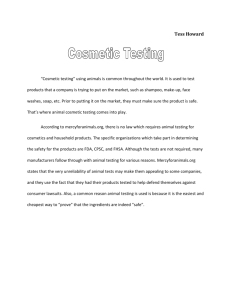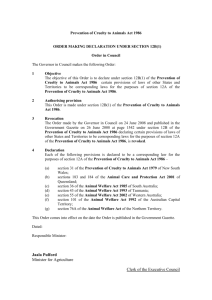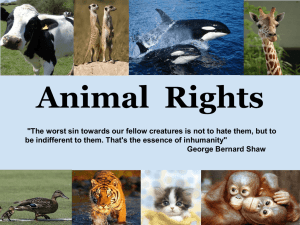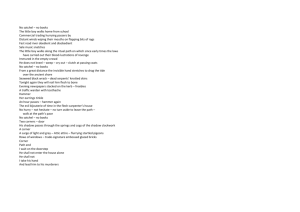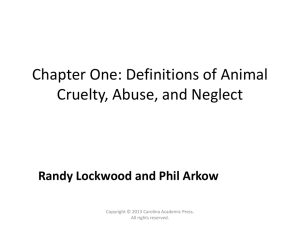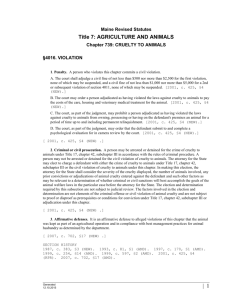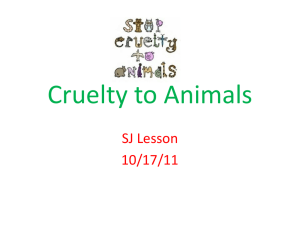Explaining Cruelty
advertisement
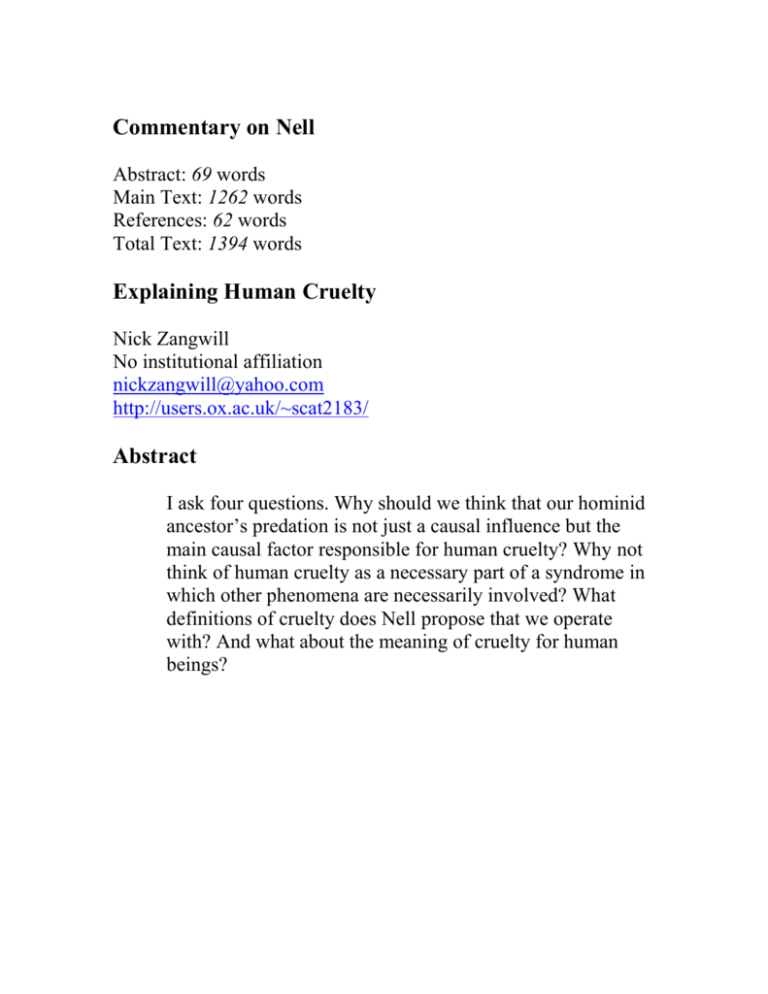
Commentary on Nell Abstract: 69 words Main Text: 1262 words References: 62 words Total Text: 1394 words Explaining Human Cruelty Nick Zangwill No institutional affiliation nickzangwill@yahoo.com http://users.ox.ac.uk/~scat2183/ Abstract I ask four questions. Why should we think that our hominid ancestor’s predation is not just a causal influence but the main causal factor responsible for human cruelty? Why not think of human cruelty as a necessary part of a syndrome in which other phenomena are necessarily involved? What definitions of cruelty does Nell propose that we operate with? And what about the meaning of cruelty for human beings? Victor Nell argues that human cruelty has its origin in “predatory adaptation from the Middle Cambrian to Pleistocene” (Nell MS, p 1) He says that this explains the widespread and ingrained nature of human cruelty. I think that there is probably some truth in this speculation. However, I have worries about whether the evidence he cites supports the speculation, and I have worries about the content of the speculation. I shall put four questions. 1. Nell describes the multifarious and widespread phenomena of animal and human cruelty. And he makes it plausible that the nature, frequency and distribution of cruelty should be given an evolutionary explanation. However, I cannot see that Nell has shown that his particular evolutionary speculation is better supported by the data than other possible rival evolutionary hypotheses. It is true that predation involves many of the features of human cruelty and it is thus plausibly seen as a historical source of human cruelty. But why should it be seen as the unique source? Our ancestors of the Cambrian to Pleistocene era did much besides predation. They also fought, fled and fornicated. In particular, human beings and many other species spend an awful lot of time and effort fighting and even killing members of their own species. Predation, by contrast, is typically is directed at other species. Quite a lot of fighting within a species has to do with hierarchies, which are central in mating strategies. Some fighting within species may have to do competition between groups for resources. Richard Wrangham and Dale Peterson describe groups of chimpanzees killing chimpanzees from other groups (Wrangham and Peterson 1996, chapter 1). But much fighting within species, particularly between males, only aims at establishing hierarchies and does not involve death. It does nevertheless often involve pain and blood. So such fighting is also a possible alternative source of current human cruelty. Moreover, there may be other possible contenders, perhaps in addition to the rival one that I have just mentioned. So the first question I’d like to ask Nell is this: although I am persuaded that there is causal influence from our hominid ancestor’s predation to human cruelty, why should we think that this causal influence is the main causal factor? Why is it not just one factor among others? 2. I am unhappy with Nell’s atomism about the phenomena of cruelty. The worry applies equally to human and animal cruelty, but we can make the point most vividly for human cruelty. The point is one Nietzsche makes (Nietzsche 1973, section 259 and elsewhere). Nietzsche would ask: to what extent is human cruelty a necessary part of a syndrome in which other apparently different phenomena are necessarily involved? Nietzsche thought that a world without human cruelty would also be a world without many things that we do or should value. In particular, he thought that the barbarism of human cruelty is holistically intertwined with many of the highest achievements of ‘Western high culture’. To simplify, Nietzsche would have said: No cruelty, no creative genius. For Nietzsche, the urge to human cruelty is irretrievably locked together with many admirable things in human life; creative and destructive urges are necessarily linked so that one cannot have one without the other. Freud’s later view was different since he separated creative and destructive urges, and thought that one or the other was usually dominant (Freud 1994); for Nietzsche, by contrast, the two urges are necessarily tied together. So my second question to Nell is: why the atomism? 3. The phenomenon or phenomena of human cruelty, while it may have animal origins, is overlaid and transformed by cultural and ideological meaning; so it is not clear how far we are entitled to think of animal and human cruelty as instances of the same phenomena. This worry is partly, but not wholly, a pedantic one about what we are to mean by the word “cruelty”. Let us start there, however. Cruelty is surely not “the deliberate infliction of physical or psychological pain on a living creature” (Nell, MS, p.1). A doctor might deliberately inflict physical pain on a patient in the course of an operation, and a therapist might inflict psychological pain in the course of therapy that is intended to help a patient. Doctors or therapists might even take delight in causing pain if they think that it means that the cure is working. However, the doctor or therapist does not pursue or take pleasure in pain for its own sake; rather the pain is thought to be a by-product or a necessary means to what they do want for its own sake. Nell seems to recognize this, but only when we are already quite a long way into the paper; and he simply puts such cases to one side (Nell, MS, p.4). But it is unsatisfactory simply to exclude these kind of cases by fiat without modifying the definition deployed elsewhere. One cannot carry on working with the unsatisfactory definition, which does not fit the human phenomena that we call “cruel”. This matters because Nell needs a notion of cruelty that applies to both human beings and animals and which will allow him to draw conclusions about human cruelty from evidence about animals. I am not saying that this cannot be done, only that caution is in order — great caution. A proper conceptualization of human cruelty is essential to drawing any such conclusion. So my third question for Nell is: what definitions of cruelty does he propose that we operate with? 4. I am not denying that it is possible and perhaps plausible, that our animal natures are part of the explanation of human cruelty. But there is an enormous danger that the social or religious significance of human cruelty, in the minds of those who perpetrate it and suffer it, will be overlooked or underestimated. It is not clear how much we can learn from evolutionary theory alone when we consider the great human significance of blood, and therefore of the spilling of it. Consider bullfighting and foxhunting. In both, the pain-blood-death scenario of the animal is invested with a complex array of meanings by the (human) participants. (See Hemingway 1996 on the meaning of bullfighting; and see Scruton 1998 on the meaning of foxhunting.) And consider Christianity, in which one person’s pain-blood-death scenario is invested with huge metaphysical, moral and social significance. Indeed, the fate of the entire cosmos is sometimes supposed to rest on the pain-blooddeath scenario of one man: Jesus. And believing in that significance is supposed to have the power to deliver profound spiritual and metaphysical ‘salvation’. Perhaps the meaning of Jesus’ pain-blood-death in Christianity has more to do with suffering than cruelty. Nevertheless, it illustrates the transfiguration of pain-blood-death by complex meanings. There is a general issue lurking here about the relation between the human and social sciences, on the one hand, and disciplines such as biology and neurophysiology, on the other. Consider eating or sex: it is true that both animals and humans do it. But human beings invest these activities with social, moral and religious significance, and they surround the activities with complex rituals. Human beings transfigure animal phenomena by investing them with meaning. It is not clear how much of the original animal phenomena will be recognizable in the sophisticated human phenomena. So my fourth and last question for Nell is: given the layers of meaning that, for perpetrators and sufferers are part of what human cruelty involves, is there enough in common between human and animal cruelty to forge a strong explanatory link between them? References Sigmund Freud 1994: Civilization and its Discontents, New York: Dover. Richard Wrangham and Dale Peterson 1996: Demonic Males: Apes and the Origin of Human Violence, New York, Houghton Mifflin. Ernest Hemingway 1996: Death in the Afternoon, New York: Simon and Schuster. Friedrich Nietzsche 1973: Beyond Good and Evil, Harmonswroth: Penguin. Roger Scruton 1998: On Hunting, London: Yellow Jersey. Victor Nell, target article.
